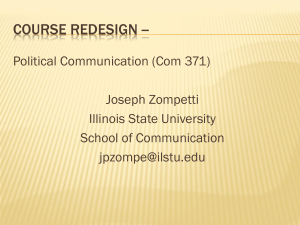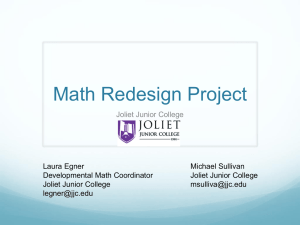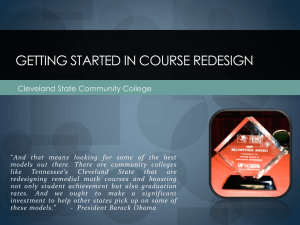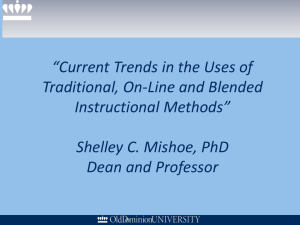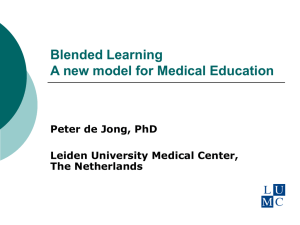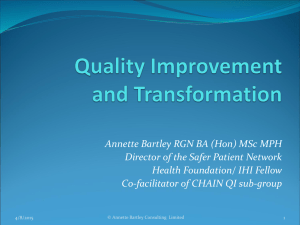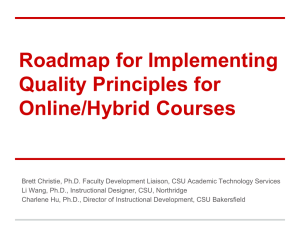The Future of E-Learning and How The University of Macau Can
advertisement
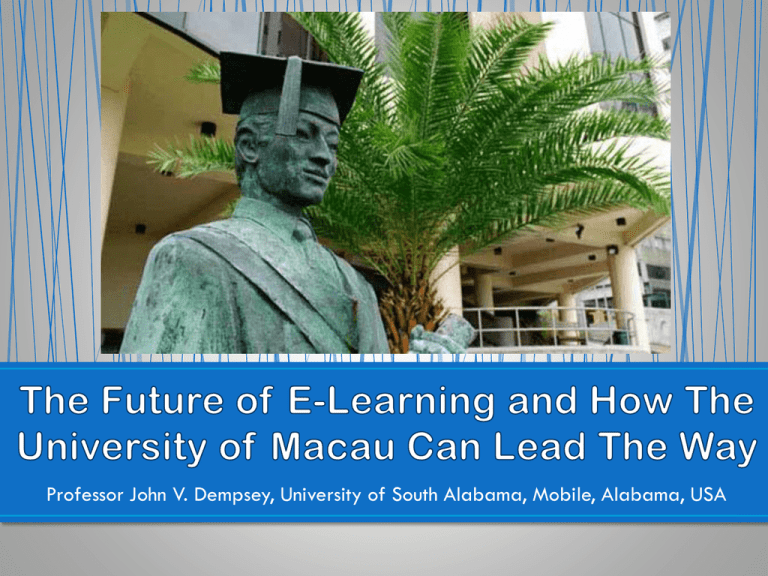
Professor John V. Dempsey, University of South Alabama, Mobile, Alabama, USA • Brenda’s spouse • Director of Innovation in Learning Center • USA Online – University’s online campus Faculty Development • E-learning and course redesign initiatives • Professor of Instructional Design and Development • Former Fulbright Scholar in Malaysia • Happy to be here! 2 • • • • E-Learning formats and their effectiveness Trends and demographics in US e-Learning Trends and demographics in Asian e-Learning Case: How we increased quality and reduced costs at my university • Changing face of public university education • How the University of Macau could lead the way • Other questions? 3 • E-learning comprises all forms of electronically supported learning and teaching. (Wikipedia) 5 Asynchronous + Self-paced formats Synchronous 6 7 • Web-enhanced •Less than 5% online or out of class • Blended (hybrid) •5-85% online or out of class • Online • 85-100% online or out of class 8 USDOE meta-analysis* “Students who took all or part of their class online performed better, on average, than those taking the same course through traditional face-to-face instruction.” “Instruction combining online and face-to-face elements had a larger advantage relative to purely face-to-face instruction than did purely online instruction.” *Evaluation of Evidence-Based Practices in Online Learning: A Meta-Analysis and Review of Online Learning Studies, Washington, D.C., 2010. 11 12 13 14 15 • Australia • South Korea • Japan High use • Singapore • India • China • Malaysia • Thailand • • • • • • • • • Sri Lanka Indonesia Philippines Pakistan Nepal Vietnam Cambodia Laos Bhutan Mid use Low use 17 • Indonesia strictly controls the quality of academic distance learning content. It is difficult for foreign companies to enter into their domestic market. • China has a strict system to approve e-learning programs. No foreign countries are allowed to tender for government contracts. 18 • South Korea intends to use e-learning solutions to train all primary and secondary school students. • Thailand has plans to provide all students with tablets by 2012. • China aims to have over 200 million students online by 2020 19 4.5 4 3.5 3 2.5 2 1.5 1 0.5 0 2004 2005 2006 2007 2008 2009 2010 2011 20 • Private K-12 - Edu.china.com and Yuloo.com • ChinaEdu Corporation 165,000 students in online degree programs • Corporate training China-training.com Enterprise Learning Center – Xuexugang.com Chinaonlineedu.com 21 • University - Chinese Learning Net & Renmin Univ • Open University of China (Central Radio and TV U) 68 online colleges 140 majors in 10 areas 2,027 off-campus learning centers Total enrollment of 1.4 million 22 • 33% English • 16% Chinese • 7% Japanese • 3% Korean • 3% Arabic • 38% Other 23 • • • • • Financial crisis Decreasing state support Increasing demand for flexible learning opportunities LMS decision Better technology options Administrative Initiative: • Critical support--by Senior VP (Provost) • Strong buy-in from Deans • Involved faculty leadership • 37 faculty Proposals respond to SVPAA’s call • Up to 18,000 annual course enrollments affected long term • 25 pilots started fall 2010 semester A&S 20 Course Enrollments 12,220 CESP 6 1,946 CIS 2 1,887 COE 4 445 MCOB 5 1,418 37 17,916 College Proposals modernize systems urban university economic pressures Principles: Improve Quality Increase Cost Efficiency USDOE meta-analysis* “Students who took all or part of their class online performed better, on average, than those taking the same course through traditional face-to-face instruction.” “Instruction combining online and face-to-face elements had a larger advantage relative to purely face-to-face instruction than did purely online instruction.” *Evaluation of Evidence-Based Practices in Online Learning: A Meta-Analysis and Review of Online Learning Studies, Washington, D.C., 2009. • Description of specific innovation • Instructional efficiency goals as measured by instructional salary/credit hour production • Rationale for choosing the innovation • Costs associated with implementation • Time frame Faculty for Proposal piloting redesign Cont’d • Evaluation plan to demonstrate improved quality and cost efficiencies • Sources of baseline information • Baseline instructional costs • How active learning results • How student learning is measured Proposal Review • The Supplemental Model • The Replacement Model • The Emporium Model • The Fully Online Model • The Buffet Model • Linked Workshop Model Math Emporium Lab at Univ. of South Alabama • Focus •High enrollment courses •eLearning • usually blended format U. South Alabama • 37 redesign proposals (first round) • affecting estimated 4,400 undergrads 11% Whole Course 13% Certain Sections 76% New or Combine Course • Creative eLearning technologies • lecture capture • interactive instructional materials from publishers • online tutoring • guided examples • team case studies • expert guests • Active on-campus learning sessions • Structured team-based problems • Cases and inquiry learning scenarios • Oral and project presentations • Large group content review • Strategic quizzing; practice tests • Critiques and discussion Professional Development • NCAT and Sloan-C Conferences and workshops - 3 groups of faculty • Innovation in Learning Center workshops • ILC Redesign website • Evaluation assistance • Redesign Academy (3 days w/ honorarium) • Redesign Faculty Get-Togethers Direct Support • New Institutional tools (iTunesU, Camtasia Relay, Kaltura, Big blue Button) • Personal Tools (laptops, software) • E-Learning Assistant Program ILC staff shooting video of blended course activities Peer Modeling • Some eLeader program topics: • Creating screencasts for Political Science • Using online debates in Community Health courses • Assessment--matching Engineering outcomes • iTunes U in Real Estate courses • Using Wikis in Library Science • Presentation skills for video in Nursing courses • Preparing student review podcasts om Business • Virtual Engineering chalkboard Cost Indicators • Comparison of Methods Institutional • Personnel cost per Student • % Change in personnel cost per student • Course enrollment • Reduction in part-time instructors and GAs Course Specific • Reassign faculty assignments • Time for research and grant-seeking Quality Metrics • Comparison of Methods Institutional • Student Success rates • D/Fs, • WDs Course Specific • Common Final Exams • Common Content Items Selected from Exams • Pre- and Post-tests • Student Work Using Common Rubrics Redesign Comparison % Change Course enrollment 3300 3916 Full-time instructors 29 54 Part-time instructors 20 38 GA’s (teaching only) 0 1 Avg FT instructor cost per student $87.17 $123.85 -28.8% Avg PT instructor cost per student $15.53 $25.05 -38.0% Total Personnel cost per student incl. GAs support personnel $125 $152 -22.3% Redesign Comparison % Change Course enrollment 3,150 3,296 Full-time instructors 25 38 Part-time instructors 24 31 GA’s (teaching only) 0 1 Avg FT instructor cost per student $78.21 $108.83 -28.2% Avg PT instructor cost per student $16.73 $22.43 -25.4% Total Personnel cost per student incl. GAs support personnel $110.28 $133.35 -17.3% Redesign Frequency Comparison Percent Frequency Percent 2,078 63.0 2,640 67.4 D/F Rate 830 25.2 886 22.6 WD Rate 389 11.8 390 10.0 3 0.1 0 0.0 3,300 100.0 3,916 100.0 Success Rate Incompletes Total Students Redesign Frequency Comparison Percent Frequency Percent 2,008 63.7 2228 67.6 D/F Rate 739 23.5 716 21.7 WD Rate 402 12.8 352 10.7 1 0.1 0 0.0 3,150 100.0 3,296 100.0 Success Rate Incompletes Total Students • Working with administrators and faculty to improve or restructure course redesign • Alert chairs and deans to problems • Discuss course redesign changes with Depts. • Ongoing reports to VP • Identify most effective and efficient courses • Determine commonalities that resulted in success USA Redesign Academy • Structure • Activities • Course formats • Targeted faculty training • Student support from faculty members • Initial student orientation help create structure • Changing from online to more structured blended format for 100-level courses • Evaluate savings in classroom use Student Orientation Video prepared by the USA Innovation in Learning Center. On average (all courses) : • Success rates were highest for blended and online courses versus the traditional or webenhanced course format. • Withdrawal rates were lowest for blended courses and highest for online courses. • Class sizes were largest for the blended format; smallest in the traditional format. 50 • Students in tertiary education worldwide increased from 28 in 1970 to 165 million in 2010—almost 600% more students. • Academic degree standards and quality assurance standards becoming more compatible (e.g., Bologna Accord) • Alliances among universities to spread out costs (e.g., software services) and inter-institutional exchanges. 52 • What usually occurs in university classrooms will move from presenting to managing interactions: • Between students and instructor • Between students and students • Between students and learning technologies 53 • Complete Lectures and Materials • Edx (Harvard & MIT) • Peer-to-Peer University • Stanford Project • Repositories • Merlot • EdReNe • Multimedia University (Malaysia—local to University and partners) • Khan Academy 54 Particularly structured approaches like Team-Based Learning (TBL) 55 • • • • E-textbooks Established publishers University faculty Consortium faculty 56 • Institutional administrative support - KEY • Planning – maintaining standards • Intense redesign initiative • Instructional design • Faculty development • Student development • Monitoring & Evaluation 58 1. Make sure you have a clear business case Using resources (time, human talent, space, money) strategically IS critical to any institution 2. Use Data to guide decisions Published external research, institutional research and evaluation systems, analysis of market, timely opportunities, 3. Engage early with all relevant stakeholders Institutional change is political and personal 4. Focus on integration, open standards and build upon existing communities of practice For content (collaborative institutional partnerships, learning repositories, open educational resources, open-source software communities) 59 Opportunity • Bilingual faculty Innovation Possibility • Bilingual courses • Limited summer courses • Online and blended • Working professionals need educational upgrades • Flexible formats for busy professionals 60 Just a few… • Electronic textbooks • Podcasts • Virtual field guides • Mobile data collection • New content creation • Mobile computing labs Introduce topic Illustrate procedure Scenes from an instructional podcast Provide guidance 62 • Just wanted to let you know--we’ll be in your living room soon.. • • • • • • • Value change and innovation Don't reinvent wheel Look for best practices Visit other places Bring in a few consultants Pick and choose and get the best fit for UM UM can lead the way in developing e-Learning for the region 64 65 66


